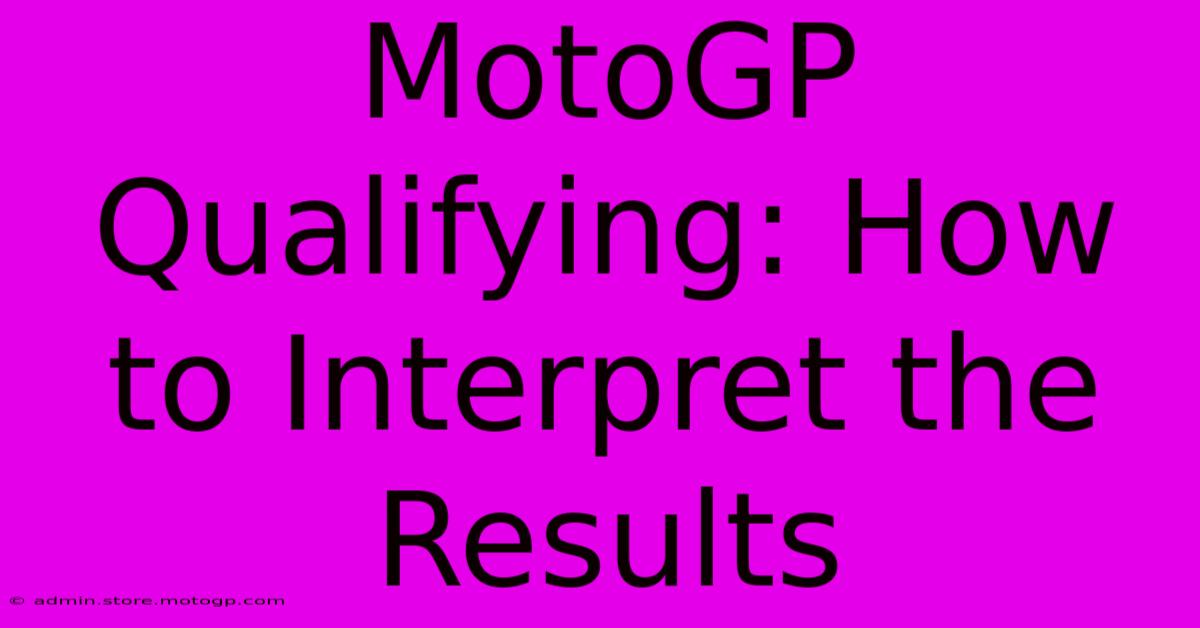MotoGP Qualifying: How To Interpret The Results

Table of Contents
MotoGP Qualifying: How to Interpret the Results
MotoGP qualifying is a crucial part of the race weekend, setting the stage for the Grand Prix. Understanding how qualifying works and how to interpret the results is key for any serious MotoGP fan. This guide will break down the process and help you decipher the starting grid and predict race outcomes.
Understanding the Qualifying Format
MotoGP qualifying is a multi-stage process designed to separate the fastest riders from the rest of the pack. The current format typically involves:
Free Practice (FP1, FP2, FP3):
These sessions are crucial for riders to get acquainted with the track, test different bike setups, and gather data. While they don't directly determine the starting grid, the fastest lap times from these sessions influence the participants in the qualifying sessions. Riders collect crucial data on tire wear, bike stability, and optimal race lines. These sessions are important for establishing a baseline performance.
Qualifying 1 (Q1):
The riders with the slowest combined times from the three Free Practice sessions compete in Q1. The top two riders from Q1 automatically progress to Q2. This session is often frantic, with riders pushing their limits to secure a place in the next round. Analyzing Q1 performance can highlight potential dark horses who may have struggled in FP sessions but found their pace.
Qualifying 2 (Q2):
The top 10 riders from the combined FP times automatically advance to Q2, joining the top two from Q1. These 12 riders battle for the coveted pole position. Q2 times are vital; they determine the front of the grid. A strong Q2 performance indicates a high likelihood of a top finish in the race. Noteworthy is to observe how consistent a rider is throughout Q2, as it can reveal their potential race pace.
Interpreting the Results: Beyond the Grid Positions
The starting grid is just the beginning. Analyzing qualifying results offers a wealth of information beyond just the final positions:
Fastest Lap Times:
The fastest lap times in Q2, and even Q1, offer an indication of a rider's raw speed and potential race pace. A rider consistently setting fast laps shows strong potential for a competitive race, regardless of their final grid position. Compare lap times across different riders to understand their comparative speed.
Tire Choice and Strategy:
Observe the tire choices riders make during qualifying. This provides insight into their race strategies. A rider opting for a softer tire compound in qualifying might suggest an aggressive race strategy, while a harder compound may point towards a more conservative approach. Pay attention to this to understand their potential performance.
Consistency:
Look beyond the single fastest lap. A rider with consistently strong lap times throughout qualifying is likely to be more reliable and consistent throughout the race. A rider with a single blistering fast lap but inconsistent performance may be a wildcard.
Gaps to the Leader:
The gap between riders is equally as important as their positions. A small gap suggests a close battle and an exciting race ahead. A significant gap might hint at a dominant rider. Observe the time differences between riders to assess the competitiveness within the grid.
Performance Across Different Sectors:
Analyzing sector times reveals where riders are excelling and where they may be struggling. This can help predict potential overtaking opportunities during the race. This level of detail is crucial for serious fans.
Using Qualifying Results to Predict Race Outcomes
While not foolproof, analyzing qualifying results can give you a strong indication of what to expect in the race. Consider these factors:
- Starting Position: Pole position offers a massive advantage, especially at circuits with overtaking difficulties.
- Race Pace: Qualifying often doesn’t entirely reflect race pace, but consistently fast laps indicate a rider who can maintain a strong pace.
- Bike Performance: Observe which bikes are dominating qualifying. Does this suggest a stronger overall performance in the race?
- Weather: Remember that sudden changes in weather can drastically alter race conditions and qualifying results.
By carefully analyzing all aspects of the qualifying sessions, you can gain a deeper understanding of the MotoGP race, enhancing your enjoyment and providing more informed predictions. Enjoy the racing!

Thank you for visiting our website wich cover about MotoGP Qualifying: How To Interpret The Results. We hope the information provided has been useful to you. Feel free to contact us if you have any questions or need further assistance. See you next time and dont miss to bookmark.
Featured Posts
-
Circuit Of The Americas The Hottest Merch In Texas
Feb 17, 2025
-
Moto Gp Vs F1 A Battle For The Ages
Feb 17, 2025
-
Formula 1 Parking Avoid The Last Minute Rush
Feb 17, 2025
-
Mastering Your V 4 Yamaha
Feb 17, 2025
-
Queen Circuit Adventures Making Memories That Last
Feb 17, 2025
